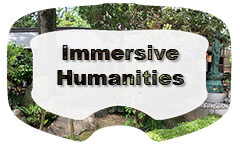
Project team members working on the Virtual Shikoku Pilgrimage project traveled to Japan and the island of Shikoku in May 2019 to research aspects of the pilgrimage through visits to archives and places related to the life of Kukai, and to experience a portion of the Shikoku pilgrimage itself. Faculty mentors and students explored the history and cultural significance of the pilgrimage while in Japan, and shared experiences with other pilgrims, local residents, and the priests and temple workers. The students’ individual research projects focused on both content development for the virtual platform and development of design elements and technical functionality based on their experiences in the real landscapes of Shikoku.
Since the completion of the research trip to Japan, the project team members have been working on the design and development of a Virtual Shikoku Pilgrimage technical prototype, which was presented at the 2021 ASIANetwork Annual Conference.The first prototype focuses on the first three temples in the 88-temple Shikoku pilgrimage, and we are continuing a multi-year effort to expand the Virtual Shikoku Pilgrimage platform to eventually include the entire pilgrimage.
Each temple will be recreated digitally as a virtual place and then digital stories will be embedded within the temples through multimedia elements, such as text, audio, and video. Samples of the these multimedia features were collected during the research trip to Japan, and were used to develop the first digital stories for Temples 1-3 in the pilgrimage.
Current work on the Virtual Shikoku Pilgrimage project is focused on three areas: 1) upgrading the platform to leverage new functionality in the Unity framework, 2) expanding the multimedia content in the temple exploration spaces, and 3) working on the design and content for the next set of temples in the pilgrimage. As we develop our content, we continue to explore some of the challenges in representing the ephemeral cultural and spiritual aspects of the pilgrimage experience as digital objects.
